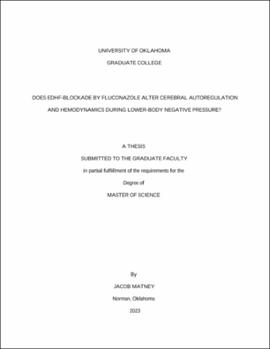| dc.description.abstract | Animal models suggest that cytochrome P450 2C9 (CYP450), an enzyme within the EDHF pathway, plays a critical role in the control of cerebral hemodynamics and autoregulation. However, this observation has not been directly examined in humans. PURPOSE: To determine the contribution of EDHF to cerebrovascular hemodynamics in healthy young individuals at rest and during mild simulated hypovolemia via blockade of cytochrome P450. METHODS: 16 subjects (9 females, tested only during early follicular phase) participated in 1 familiarization and 2 experimental visits. In experimental visits, participants ingested either a CYP450 inhibitor, fluconazole (FLZ 150mg) or a microcrystalline cellulose placebo (PLA 250mg) in randomized, single-blind, crossover design. Following 120 minutes of supine rest after ingestion middle cerebral artery velocity (MCAv, cm/s, Transcranial Doppler), mean arterial pressure (MAP, mmHg, finger photoplethysmography), prefrontal cortex oxygenation (TSI, %, Near-Infrared Spectroscopy) were continuously measured during 5 minutes of supine rest and 5 minutes of lower-body negative pressure (LBNP, -20mmHg). Cerebrovascular conductance index was calculated (CVCi = MCAv/MAP, cm/s/mmHg). Further, gain, coherence, and phase were determined using transfer function analysis of MCAv and MAP data. RESULTS: Resting values for all variables were not different between treatments (p > 0.05). Therefore, all data are presented as a change () from rest to LBNP ± SD. MCAv decreased from rest to LBNP with FLZ (p = 0.001) but did not differ between treatments (PLA -3.11 ± 7.04 vs. FLZ -6.61 ± 6.00 cm/s, p = 0.17, d = 0.36). Similarly, CVCi decreased between rest and LBNP for FLZ (p = 0.02), but did not differ between treatments (PLA -0.04 ± 0.09 vs. FLZ -0.06 ± 0.06 cm/s/mmHg, p = 0.19, d = 0.35). FLZ responses to LBNP were significantly different than zero for both CVCi and MCAv measures (ΔMCAv -6.61 ± 6.00, p = < 0.001, r = 0.622; ΔCVCi -0.06 ± 0.06, p = 0.001, r = 0.549). TSI was unaltered from rest to LBNP, nor by treatment (PLA 0.03±1.45 vs. FLZ -0.02±1.25 %, p = 0.41, d = 0.213). Transfer function analysis was performed but not interpreted, as coherence values were not consistently above 0.5, which is not an unanticipated result when analysis is applied to healthy young adults. CONCLUSION: This study indicates that cytochrome P450 inhibition does not affect middle cerebral artery velocity, CVCi, or prefrontal cortex oxygenation at steady-state rest or during mild-hypovolemic stress. However, EDHF-blockade does appear to alter hemodynamic responses to sympathetic stress. Therefore, these data suggest that CYP450 is not compulsory for regulation of cerebrovascular hemodynamics in healthy young adults, however, may be critical for dynamic cerebral responses to drops in blood pressure. | en_US |
